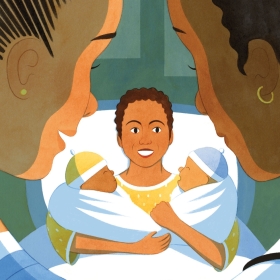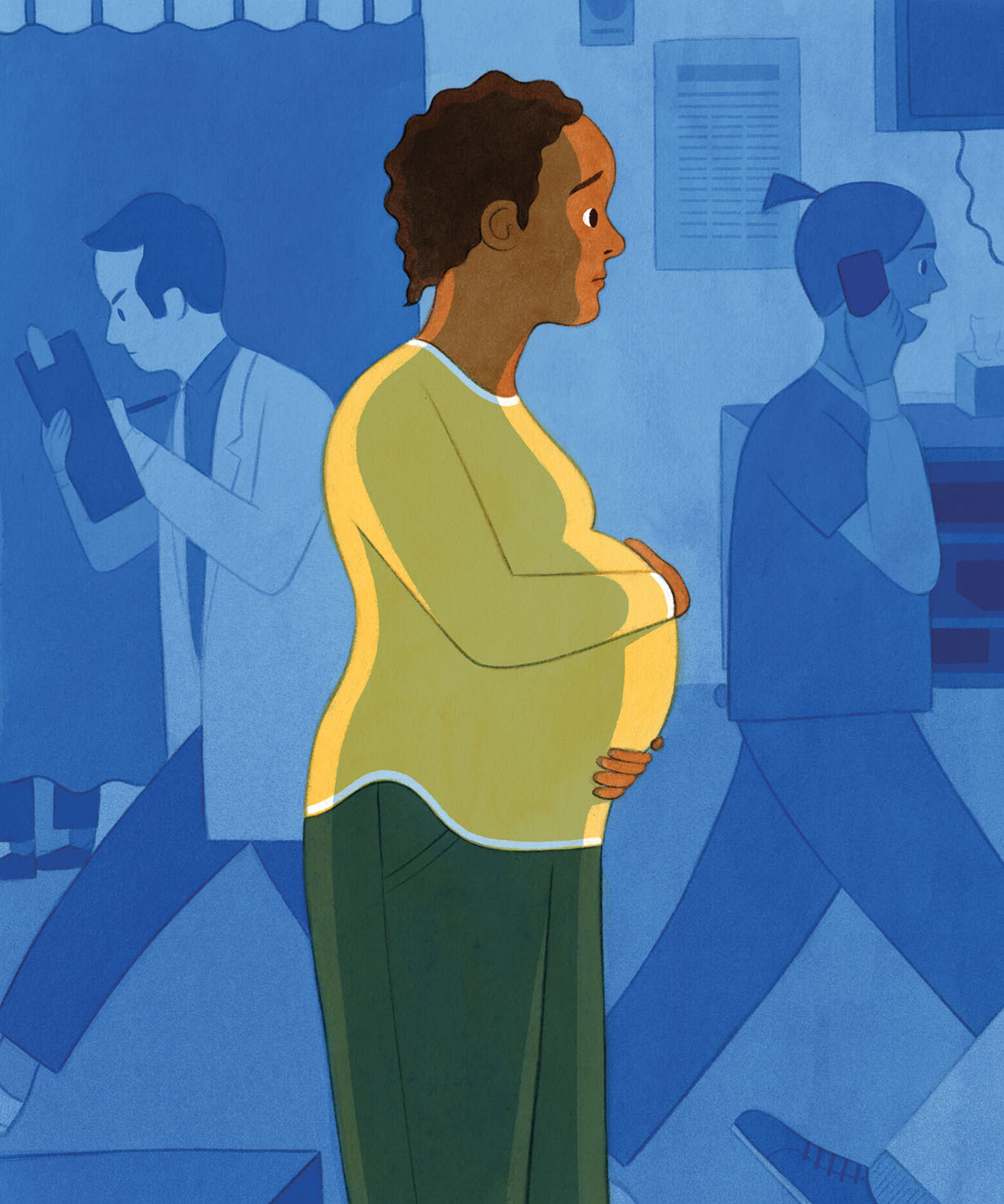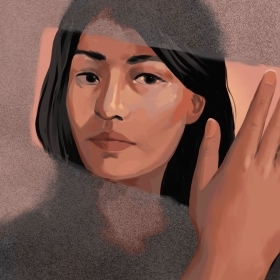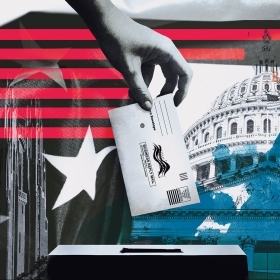Black people are more than three times as likely as white people to die from pregnancy-related causes. Wellesley medical professionals and advocates are at the forefront of addressing this maternal health crisis.
Black people are more than three times as likely as white people to die from pregnancy-related causes. Wellesley medical professionals and advocates are at the forefront of addressing this maternal health crisis.

It was September 2020, and Lynne Lightfoote ’95 had her arms full. An OB/GYN at Sibley Memorial Hospital in Washington, D.C., she doesn’t usually like to be in the spotlight, but that day, a phone camera was turned on her as she cradled newly born twin babies Fara and Femi, beaming and tearing up.
Lightfoote had been mom Folashade Butler’s doctor for nearly 15 years. The doctor was candid with her patient about her many risk factors—she was a Black woman, over 35 years old, and pregnant with twins. When Butler arrived for her 37-week checkup with swollen feet and high blood pressure, Lightfoote swiftly decided the babies needed to be delivered before Butler became even higher risk by developing preeclampsia, a serious, potentially fatal complication. The twins were delivered safely a few hours later by Lightfoote and her all-Black care team and bundled in hospital blankets and tiny hats.
“They look beautiful in your arms, Dr. Lightfoote,” Butler says in the video. “I’m so thankful to you.”
Butler posted the video on Instagram, where it was viewed hundreds of thousands of times—both a gratitude post for Lightfoote and a directive for other Black women. “Get a doctor who won’t sugarcoat health concerns,” Butler wrote. “Get a doctor who prioritizes your health and well-being. Get a doctor who will advocate for your life. Get a doctor you can trust!”
Butler’s outcome is the one Lightfoote strives for—healthy mom and healthy babies, which leads to an overwhelming feeling of relief and joy for Lightfoote that hasn’t worn off after decades in delivery rooms. Unfortunately, that’s not the outcome for too many Black people in America. According to the Centers for Disease Control and Prevention, Black women are more than three times as likely to die from a pregnancy-related cause than white women. American Indian and Alaska Native women are more than twice as likely to die than white women. Disparities exist even when factors like education level and income are controlled for; tennis champion Serena Williams’ harrowing experience after giving birth to her daughter in 2017 brought national attention to the issue. And since Roe v. Wade was overturned last year, more people could potentially face adverse outcomes.
The causes for this inequity run deep—including lack of access to quality health care and systemic racism and implicit bias in medicine and society. Wellesley medical professionals and advocates are at the forefront of working to improve outcomes for Black birthing parents and their babies. That includes training medical staff to be more culturally competent, strengthening trust between doctors and patients, widening access to health insurance and care, and working to achieve health equity by naming racism and inspiring action.

Crucial Conversations
When Lauren Young Durbin ’99 was pregnant with her twins, she had a lot of fears. As a Black woman, she was acutely aware that she and her babies were at high risk for complications. Most of all, she worried that her pain wouldn’t be taken seriously.
“If I seem to be in any kind of pain,” Durbin, an attorney and career coach, told her husband, “I need you to use all your middle-aged white male privilege to make sure I get proper care.”
Her pregnancy was mostly uneventful, but in September 2021, around 36 weeks, she was sent to the hospital with high blood pressure—much like Butler. Her babies were soon born via cesarean section, and she doesn’t remember much after that. She later learned she had started having seizures, her blood pressure was still high, and she was bleeding internally. About a week later, she woke up from a coma, strapped down and still ventilated, fighting to get up. She recalls being very confused, unaware of what had happened, and feeling like an “animal in a zoo” as medical staff came in and out of the room to talk about her case.
“They’d come by with three to four people a day,” she says, “saying, ‘We thought you were going to die.’” But, she says, nobody told her what had happened until her OB/GYN visited her in the ICU.
It was in that ICU, she says, that her fight-or-flight mode kicked in. “[I] willed myself to get out of there,” she says. But when she was sent home, she was still unable to walk, bleeding a lot, and in pain. The bleeding got worse, and despite sending messages to her doctor, it wasn’t until about two months later that she was examined again—typical for postpartum care in the U.S. The doctor walked in the room, she says, and declared that bleeding was totally normal. But an exam revealed she had blood clots so large she needed a second surgery.
Looking back, Durbin says that at the very least, better communication between her and her providers, almost all of whom were white, would have helped them catch some of her complications earlier and made her feel more able to advocate for herself. Doctors and other medical providers, she says, should “believe [their] eyes and experience in addition to what the patient is saying. Think about whether or not this makes sense.”
Pregnancy is among the biggest stress tests a body can go through, Lightfoote says: “In addition to the stressors that Black women experience on a regular basis, it’s even more of a stress test [on them]. … It’s like adding insult to injury, and nothing about pregnancy should be an insult.”
Lightfoote and her colleagues in her practice work every day to help prevent many of the avoidable complications Black women face during and after pregnancy.
She acknowledges that being a private physician whose patients have private insurance allows her to care for the same people for years and become intimately familiar with their medical histories and risk factors. That kind of relationship is nearly impossible to build, she says, for patients without insurance or who are on Medicaid, because they may see different providers throughout their pregnancies.
Still, things can happen lightning fast in a delivery room, and there is often a need to act first and explain later—like performing an emergency C-section. That can make communication a challenge, Lightfoote says, but if patients have a strong relationship with their providers, they can still come out feeling heard and respected.
“It’s everyday for me, but it’s someone else’s unique experience,” she says. Effective communication, she says, lets patients know “I’m concerned about you, I care about you, this is what I can see is going to be the course, and this is our plan.”
Because doctors control the conversation, Lightfoote says, “We have to create an atmosphere where people can speak openly and honestly.”

Fixing Systemic Issues
JudyAnn Bigby ’73 still remembers a birth she attended as a medical student in the late 1970s. A Black teenager was in labor and didn’t have a partner or companion with her during the delivery. “She was very, very scared,” Bigby says, “and nobody was paying attention to her emotional state.” When the chief resident decided to do an episiotomy—a painful procedure that was thought to prevent vaginal tearing but is now no longer recommended routinely—the patient got very upset and reached down to push his hand away. “He got so mad at her,” Bigby recalls, berating her for endangering her own health.
Bigby has since dedicated her career to improving outcomes for not just her own patients but those throughout the country. A Wellesley Alumnae Achievement Award recipient, she served as secretary of the Executive Office of Health and Human Services for Massachusetts from 2007 to 2013 and has spent decades working in and teaching community and women’s health at Boston’s Brigham and Women’s Hospital and Harvard.
Poor maternal health outcomes, she says, are not a patient’s fault but a reflection of tangled issues in the health care system in the United States. “Most maternal health risk comes way, way before a woman is pregnant,” she says.
Improving outcomes also starts and ends with respect. “I think you cannot read a report on what Black women think about their health care,” she says, “without reading about the disrespect they feel in the health care system.”
Bigby largely points to nonmedical solutions to mitigate risk for Black birthing parents. The U.S., she says, “has medicalized pregnancy and delivery to the degree that it has among the worst outcomes of developed nations,” she says. “I wish we would get out of this cycle of thinking that more medical intervention is the solution. We really need to focus on fixing the systems.”
Bigby once worked with the city of Boston to improve its case manager system, integrating coordination among city agencies that worked on housing, food insecurity, and even crime. In 2006, Massachusetts passed its landmark health care law ensuring access to insurance for nearly all residents. As health secretary following the law’s passage, Bigby saw how access to Medicaid even before women became pregnant allowed them to access health care more regularly.
Bigby also advocates for better access to midwives, who can help advocate for patients and provide direct, holistic care throughout pregnancy, birth, and postpartum, as a way to improve outcomes.
From Afraid to Empowered
Lindsey Woodson Vick ’99 decided to become a childbirth educator and advocate while she was in labor with her second child. After a traumatic first birth, she found a midwife who worked with her to develop a plan to help her feel more in control and empowered the second time around.
Most birthing parents, she says, see their doctors for checkups, are in the hospital for the birth, and then don’t see their providers again for another six weeks—during which physical and mental health complications have time to appear or worsen. Midwives and doulas fill that gap and act as advocates to help their patients understand all their options.
When she teaches childbirth classes, Woodson Vick says most parents and partners come in terrified on day one. She delights in seeing the “spectacular transformation” when they become excited and optimistic about labor and delivery. Her goal, she says, is to guide a transition from “fearsome patient to empowered, fierce advocate.”
She starts developing relationships with her clients and their families early on in their pregnancies and checks in with them frequently after birth, often catching potentially dangerous complications. When one Black client recently complained of pressure in her chest and shoulder and headaches postpartum, Woodson Vick pushed for her to go back to the hospital, where she was discovered to have blood clots.
Medical providers are often overtaxed, she says, and that prevents them from being able to meet some of their patients’ needs, especially supporting their emotional and mental well-being and making sure they are fully informed. The consequence, she says, “is Black and brown patients fall to the bottom of the stack.”
Midwives and doulas, however, are often not reimbursed at the same rate as doctors despite providing excellent care in low-risk pregnancies, Bigby says. And, as Woodson Vick has experienced first hand, she is on call 24/7 all year long without a break.
‘You cannot provide quality care without equitable care.’
— Dana Im ’10
Addressing Biases
Emergency physician Dana Im ’10 doesn’t remember ever seeing a doctor after her family moved to Southern California from Korea when she was 11—until she became a student at Wellesley. Her parents owned a small store, she says, and they couldn’t afford insurance. They relied on emergency care, but more often, they just passed on obtaining care because of its cost. Her dad was once assaulted at his store—hit in the head by a skateboard, he blacked out—but even then, he did not seek medical care.
The message to Im, even at a young age, was clear: “We didn’t feel entitled to care,” she says, “not entitled to healthier lives.”
At Wellesley, she became more aware of disparities in how people access care, including preventative care. She went on to Harvard Medical School with a passion for becoming an advocate for people like her parents and found that the emergency department serves as a safety net for those patients.
Now an emergency physician at Brigham and Women’s Hospital, she helps her department recognize and address its own biases and behaviors.
Im’s department recently examined racial disparities in its use of restraints. “[It is] one of the worst things we do to our patients,” she says, but it is sometimes necessary to keep patients and others around them safe. They found that physical restraints were used more often with Black and Hispanic patients than with their white counterparts in the ER. “That was eye-opening to us, and very shocking—but at the same time, not very shocking given the structure of racism,” Im says.
Im now uses such data to lead training for the department’s staff—about 200 have attended so far—in anti-racism and trauma-informed de-escalation. It’s important to have a safe and honest setting, Im says, to allow physicians to examine the data and talk about how they can improve. The sessions are for anyone in a patient-facing role, including doctors, nurses, and security staff. In one part of the training, Im asks participants to imagine working in the ER and admitting a 55-year-old male patient who was picked up at a train station agitated and intoxicated, then, to imagine a 22-year-old male patient coming from a party at Boston College, also agitated and intoxicated. The lesson: “If you’re human, you’re biased,” Im says. The training, she says, gives participants a crucial space to reflect on how and why they’ve imagined each patient differently, and how they would prepare to treat them.
Im and her team also emphasize “treating all our patients as if they’ve had some trauma. We need to think about how we can provide care that is not traumatizing,” she says.
The training is then reinforced in practice. If a patient reports a negative experience or a provider reports a safety event, they can also note whether there was a concern about racial equity. A dedicated team then reviews those concerns and brings them back to frontline staff with actionable items.
Im says the key is the willingness of her institution to be introspective and have difficult conversations about what can be improved. “[When you learn] the data about your own institution where you’re working, you start to think, ‘What am I doing wrong, and how can we improve it?’ ” she says. “We have committed to looking at health equity that is a part of quality improvement. You cannot provide quality care without equitable care.”
Recognizing Racism
Despite the best efforts of medical providers to improve care, many agree that those efforts are really like putting a Band-Aid on a much larger wound.
To Camara Jones ’76, the disparity in maternal health outcomes comes down to one thing: “That our full humanity [as Black women] is not acknowledged or valued.” A family physician, epidemiologist, and Alumnae Achievement Award recipient, Jones has spent decades examining the impact of racism on Americans’ health.
“If we really want to eliminate racial health disparities,” she says, “then we have to understand that these ‘race-associated’ differences in health outcomes are reflecting racism, and we have to talk about anti-racism.” It’s a hard thing to do in the U.S., she says, “because racism denial is staunchly held by so many.”
Asked how an issue so deeply entrenched can be addressed, Jones has a surprisingly straightforward answer: She proposes a four-part policy agenda for anti-racism. First, she says, the U.S. should provide reparations to African descendants and Indigenous nations—apologizing for the enslavement of African people and the taking of Indigenous lands, acknowledging the foundational roles of stolen labor and stolen land in building the country, and providing financial and decision-making compensation to their descendants. Next, the U.S. should abolish prisons, which incarcerate Black Americans at a staggeringly higher rate than white Americans. Third, the U.S. should make massive “Marshall Plan” investments in communities of color, including around education, housing, and environmental cleanup. And last, she calls for deep investments in all children and their families, since all children are “our” children.
Those are big ideas, but Jones says it all starts with the country acknowledging that racism exists and having a national conversation on racism to launch a national campaign against it.
Like every other Black doctor interviewed for this story, Jones has felt her own voice go unheard in a delivery room, despite being a physician herself. When she was in labor with her first child, she says, a nurse came in and dialed up the Pitocin—a drug meant to help labor along—and then ignored her when she asked about it.
Jones asserts that nobody should be giving patients the feeling, “Who do you think you are, to question me?” “Who you are,” she says, “is a whole human being who should be respected and valued.”
Amita Parashar Kelly ’06 is a supervising producer at NBC News and a grateful mother of two children who, despite complicated births, were safely brought into the world.


